The Middle of the World
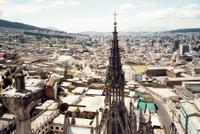 Quito, the capital of Ecuador, is nestled high in the Andean mountain range. It flows along the base of a shallow valley: a river of concrete houses meandering its way amongst tree covered mountains. A sign at the airport informs new arrivals that they are now 2,850 meters above sea level. The highest mountain in Australia, the mighty Kosciusko, reaches a mere 2,228 meters on a good day. Up here the air is dry and thin, and it takes a few days for an oxygen-loving lowlander such as myself to adjust.
Quito, the capital of Ecuador, is nestled high in the Andean mountain range. It flows along the base of a shallow valley: a river of concrete houses meandering its way amongst tree covered mountains. A sign at the airport informs new arrivals that they are now 2,850 meters above sea level. The highest mountain in Australia, the mighty Kosciusko, reaches a mere 2,228 meters on a good day. Up here the air is dry and thin, and it takes a few days for an oxygen-loving lowlander such as myself to adjust.I expected Ecuador to be hot, with steamy, sweaty days and warm sleepless nights. A reasonable expectation in my opinion since the Equator pretty much cuts the country in half. I admit that I struggled with the finer points in my high school physics, but it's my understanding that the Equator is pretty much where the sun hangs out on its days off. Sure, we're a few thousands meters up from the warm, coastal lowlands, but that just means we're a little closer to the sun, which means it should be hotter, right?
Despite my irrefutable logic, the weather remains unconvinced. I shiver my way through the cold Quito nights. My ever-present beanie and my two jumpers provide my only protection against the cold, biting air. During the day I usually get by with a T-shirt and a pair of jeans. However, the cold mountain breeze lurks in the shadows, always ready to pounce should the sun lose concentration for even an instant, distracted by a passing cloud.
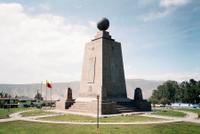 It's only a short bus ride from Quito to the Equator, that mystical, invisible line that cleaves the Earth in two, separating North from South. A group of French scientists spent a couple of years here in the 1700's using complex calculations to determine the exact location of the Equator. A huge monument and historical park have been constructed around the site, commemorating the work of the scientists and marking the location for curious visitors.
It's only a short bus ride from Quito to the Equator, that mystical, invisible line that cleaves the Earth in two, separating North from South. A group of French scientists spent a couple of years here in the 1700's using complex calculations to determine the exact location of the Equator. A huge monument and historical park have been constructed around the site, commemorating the work of the scientists and marking the location for curious visitors.Somewhat embarrassingly for all those involved, the French scientists were a little out in their calculations (somebody probably forgot to carry the one). The true equator, located by GPS, passes virtually unnoticed some 300 meters to the north. By an unspoken consensus, all those established at the park (the monument, museums and tourist shops) have decided to overlook this minor, trivial detail and carry on with business as usual.
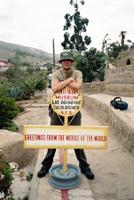 One small, family-run museum, found at the end of a poorly marked and dusty path, blows the lid on this dirty conspiracy. Here a small, aging sign made from tin and a faded red line mark the path of the true Equator. A guide takes us through the various exhibits of the museum, several of which are experiments demonstrating the peculiar scientific anomalies that occur here on the Equator.
One small, family-run museum, found at the end of a poorly marked and dusty path, blows the lid on this dirty conspiracy. Here a small, aging sign made from tin and a faded red line mark the path of the true Equator. A guide takes us through the various exhibits of the museum, several of which are experiments demonstrating the peculiar scientific anomalies that occur here on the Equator.Thanks to gravity the Earth is not quite a perfect sphere. At the Equator the Earth is fatter than at any other point and gravity is slightly less. Each of us weighs about a kilo less on the Equator than in our homelands, much to the delight of all visiting females. The fact that as soon as they move away from the Equator they will magically regain this missing kilo is conveniently and predictable overlooked.
On the equator gravity pulls straight down, from the sky to the earth. At every other point in the world, gravity combined with the rotation of the earth results in a force at a slight angle. Pour a bucket of water down a drain directly over the equator and the water just runs straight out. There's no evidence of the usual swirling whirlpool that we all expect with our years of dunny flushing experience. Move the drain into the northern hemisphere and the water runs counter-clockwise. Move it to the south and you end up with a clockwise swirl.
Another neat trick you can do on the Equator is balance an egg on the head of a nail. Since gravity is pulling straight down the egg balances nicely, standing by its own merit (if only Humpty had been Ecuadorian, a terrible tragedy could have been avoided). Even with gravity lending a hand, it takes me a few goes but eventually I succeed. I'm awarded a small photocopied certificate by the museum marking this momentous achievement in my life.
As well as the scientific games, the museum has a few cultural displays as well. One display includes the shrunken head of an unfortunate shaman, complete with nose piercings. The tiny dark head is no bigger than my clenched fist yet we can clearly make out facial characteristics. A little tuft of fine dark hair sprouts from the top making the head look like the top half of a decapitated Troll Doll.
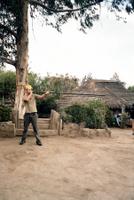 A little further on we are given the chance to use an authentic indigenous blowgun. How anyone hunted with these heavy, two-meter long poles is a mystery to me. My attempt at using it hits the target (which is better than most) but with barely enough force for the dart to penetrate. Had I been aiming for a real target, a bird say, my only chance of bagging dinner would have been if the bird dropped dead out of sheer indignation.
A little further on we are given the chance to use an authentic indigenous blowgun. How anyone hunted with these heavy, two-meter long poles is a mystery to me. My attempt at using it hits the target (which is better than most) but with barely enough force for the dart to penetrate. Had I been aiming for a real target, a bird say, my only chance of bagging dinner would have been if the bird dropped dead out of sheer indignation.Back in Quito I sign up for a few weeks of Spanish lessons. Spanish is a necessity in order for me to get the most out of this trip (i.e. hit on Latin American chics). If I stick to the Gringo trail I could probably manage with my pigeon Spanish (everything I know I've learnt from Manuel off Fawlty Towers and the Terminator movies). I have a rough plan however, to head into the Amazon and make my way by various means, hopefully including canoe, down the many rivers that flow down from the Andes and into the depths of the jungle. I have a feeling that English may not be overly common on some of these ventures.
Spanish is a nice little language with a flowing rhythm to it. Like English, Spanish has a few funny phrases that require a bit of imagination to translate. For instance where we use "look before you leap", the Spanish equivalent is "before you marry, look at what you do". Instead of making it "out of the frying pan and into the fire" a Latin American "leaves Guatemala and arrives in worse cornstalks" (though I'm not sure the Guatemalans use this saying). And my personal favorite: "I have an Aunt that plays the guitar", which is roughly equivalent to "what the hell has that got to do with anything?”
Since I'm spending a few weeks in Quito and Sasha is around for some of that time, we decide to find some decent accommodation. For the tourist, Quito is divided into two towns: the old town which is filled with old buildings, crowded little alleyways and a stupefying number of lavishly grand churches; and the new town which is crammed with funky cafes, cheap restaurants and busy hostels. We end up in a decent little hostel a little to the side of the main drag in the new town. It's a nice room with comfortable beds and they even give us towels (which is all it takes for me to be overwhelmed by the service these days - set low standards and you'll always find yourself satisfied).
The only questionable aspect of the room is the shower. A lot of showers in South America use direct electric heating for the hot water. The heating unit is actually attached to the showerhead so it sits right above you while you're showering. Normally this is not a problem but in this place the wires to the heating unit are completely exposed. Since I'm just a little taller than your average Ecuadorian my head regularly hits the showerhead. This means that my morning shower is not unlike a session of electric shock treatment. Luckily the voltage is low here and I just have to put up with a numb head for a little while after showering.
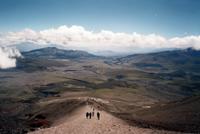 Between Spanish lessons we arrange a day trip to the huge, glacier capped Cotopaxi, the world's highest active volcano. Although quiet at the moment, this volcano last erupted in 1904 and most recently gave a little hiccup in 1975. Our guide drives us as far as the road will take us, above the clouds at a height of 4,500 meters. From there we make the arduous hike to a lookout sitting at 4,800 meters. The steep ascent and the thin air have us all panting by the time we reach the refuge, a few hundred meters below the snow line. The spectacular views both up to the lip of the crater and down to the cloud filled valleys below make it all worthwhile.
Between Spanish lessons we arrange a day trip to the huge, glacier capped Cotopaxi, the world's highest active volcano. Although quiet at the moment, this volcano last erupted in 1904 and most recently gave a little hiccup in 1975. Our guide drives us as far as the road will take us, above the clouds at a height of 4,500 meters. From there we make the arduous hike to a lookout sitting at 4,800 meters. The steep ascent and the thin air have us all panting by the time we reach the refuge, a few hundred meters below the snow line. The spectacular views both up to the lip of the crater and down to the cloud filled valleys below make it all worthwhile.The trip down is a little more exciting than the trip up. Instead of driving we mount up on sturdy mountain bikes and pedal our way down the ruggard mountain side (though pedaling is completely unnecessary). A dirt road winds slowly down the face of the mountain but I take the "shortcut" straight down the mountain. The ground is covered in small loose stones. Breaking requires careful concentration and steering requires skill and agility. I have none of these qualities and so I fly down the face of a volcano unable to turn and reluctant to break.
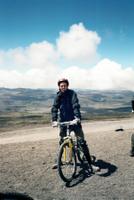 At various points my "shortcut" crosses over the zigzagging road. It's at one of these junctions that I discover an alternative to breaking which proves to be much more affective. My front tire finds a ditch and decides to stop, while the rest of my bike and myself decide to keep going. I fly forward over the handlebars with what Glover would describe as "cat-like grace" when describing his own actions in one of his many bike incidents (i.e. I go down hard like a sack of shit). The end result: an impressive full forward somersault, me lying winded on my back and my bike lying on top of me, wheels still spinning.
At various points my "shortcut" crosses over the zigzagging road. It's at one of these junctions that I discover an alternative to breaking which proves to be much more affective. My front tire finds a ditch and decides to stop, while the rest of my bike and myself decide to keep going. I fly forward over the handlebars with what Glover would describe as "cat-like grace" when describing his own actions in one of his many bike incidents (i.e. I go down hard like a sack of shit). The end result: an impressive full forward somersault, me lying winded on my back and my bike lying on top of me, wheels still spinning.No permanent damage is done so I continue on my way, finishing the ride with a little more caution and without further incident. We ride for a full two hours surrounded by glorious views until tired, sunburnt and well satisifed we climb back into our cars and return to Quito. The next day in Spanish lessons I have to look up "sore arse" in the directionary to explain why I'm having such trouble sitting down.
After a week, Sasha has moved on. She's now in the jungle doing Spanish lessons and making chocolate (I think the latter was the bigger selling point of the two) before heading south to Chile. I have one more week of Spanish here in Quito before I head once more into the unkown.
I've found myself another conservation project. Starting monday, I'll be chasing bears through the cloud forests of Ecuador for six weeks. Several Spectacled bears (so called because they have white rings around their eyes that look like goggles) have been fitted with radio collars and my job will be to follow them and gather information on their movements and activities.
Sounds fun! The project site is a good couple of hours from Internet access so postings will probably be intermittent at best.

0 Comments: